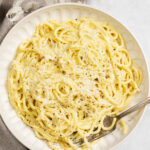Description
Cheesy, rich, and a little indulgent, this Vegan Cacio e Pepe is basically grown up mac and cheese. This easy dish packs a bunch of flavor.
Ingredients
Units
Scale
Pasta
- 1 pound (454 grams) spaghetti or other pasta (see note 1)
Sauce
- About 1 + 1/4 cup of the pasta cooking water (see note 2)
- 1/2 cup raw sunflower seeds (see note 3 for substitutions)
- 1/4 - 1/3 cup olive oil or extra virgin olive oil, optional (see note 4)
- 2 cloves garlic, peeled
- 1/2 cup nutritional yeast (see note 5)
- 2-3 tablespoons white / yellow mellow miso paste (see note 6)
- The juice of 1/2 a medium lemon, about 1-2 tablespoons
Garnish, optional
- Freshly cracked black pepper, to taste
- Freshly grated vegan parmesan or vegan parmesan topping
Instructions
- Note: If you do not have a high powered blender like a Vitamix, I advise you to soak your raw sunflower seeds (or cashews) in just boiled water until you’re ready to make the sauce--then make sure to drain them before adding them to the blender. This will help ensure your sauce is very smooth, not gritty.
- Cook the pasta: Start by cooking your pasta because you need the water from the cooked pasta to make your sauce. Because the miso is plenty salty, you might not want to salt your pasta water since we’ll be adding over a cup of the pasta water to the sauce. If you prefer to salt your pasta water, then use less miso/salt and add to taste.
- Drain the pasta and reserve the cooking water: Once the pasta is cooked through, strain it in a colander positioned over a large bowl or measuring cup in the sink. Aim to get at least 2 cups so you have plenty.
- Add the seeds and water to blender: Add the sunflower seeds to the blender and add at least a cup of the starchy pasta water. I ended up using 1 + ¼ cups but you may need less.
- Add the remaining sauce ingredients and blend: Add the olive oil, garlic cloves, nutritional yeast, miso paste, and lemon juice to the blender and blend until super smooth--I like to do a full minute in the blender. If you do not have a high powered blender, you may need to stop and let your blender rest--that’s how my old blender was.
- Assemble: Add the sauce to the pasta, toss to combine and serve as much pasta into as many bowls as you’d like. Top with a liberal amount of freshly cracked black pepper (to taste) and sprinkle with some vegan parmesan if you’d like. Enjoy!
- Serving note: You could definitely serve this with some veggies--it’d be great with some sauteed mushrooms, steamed broccoli, roasted brussels sprouts, or a side salad.
- Store: Like most pasta dishes, this vegan cacio e pepe is best on the first night, but you can store leftovers in the refrigerator for up to 3-4 days in an airtight container.
Notes
- Note 1: While any pasta will work, a nice spaghetti is best for this recipe. Use gluten-free pasta to make this dish gluten-free. Technically, tonnarelli is the most traditional pasta for cacio e pepe. However, it can be challenging to find. I like to use spaghetti or bucatini. For these photos, I used Signature Reserve bronze cut slow dried spaghetti and let me tell you… it was fantastic. Big difference from regular spaghetti, but not as thick and firm as bucatini. It was almost… fluffy? Worth it.
- Note 2: There’s something luscious and amazing about using the cooking water. A lot of starch from the pasta is released into it, and this helps emulsify the sauce and helps it stick to the pasta when you mix it all together. If you forget, it’s not the end of the world--you can use unsweetened non-dairy milk or regular water to blend it.
- Note 3: Raw cashews, white beans, or silken tofu are all good substitutes for the sunflower seeds here. Steamed cauliflower may also work. I like to use raw sunflower seeds because they are far cheaper than cashews, but richer than beans or tofu and create a lovely creamy sauce. They’re also not slightly sweet like cashews are.
- Note 4: You don’t absolutely need olive oil in the sauce but it adds to the creaminess and the flavor of the sauce. If not using oil, just add a little bit more starchy pasta water.
- Note 5: This is almost necessary to replace the cheesy flavor in the sauce. If you hate nutritional yeast I would substitute your favorite vegan cheese (yes, put it straight in the blender)--vegan parmesan or similar would be best here.
- Note 6: Miso is great in this because it not only gives it a salty flavor (we aren’t adding any other salt) but it also gives it a really delicious umami type of flavor that we’re missing without adding dairy cheese. It’s delicious, good for you (probiotic!), and it really enhances the dish. Choose mellow white or yellow miso for this dish--don’t use another kind as it will change the flavor profile. If you are soy-free, look for chickpea miso at your local health food store or in an Asian grocery. If you can’t find the miso, just use salt to taste. Start with a teaspoon of sea salt, blend, taste, and adjust as needed. You can also salt your individual bowl.
- Cook Time: 20 minutes
- Category: Entree
- Method: Stove top
- Cuisine: American, Italian
Keywords: Vegan, Nut-Free, Sugar-Free, Can be Soy-Free, Can Be Gluten-Free, Can Be Oil-Free, Vegan Pasta, Vegan Cacio e Pepe
